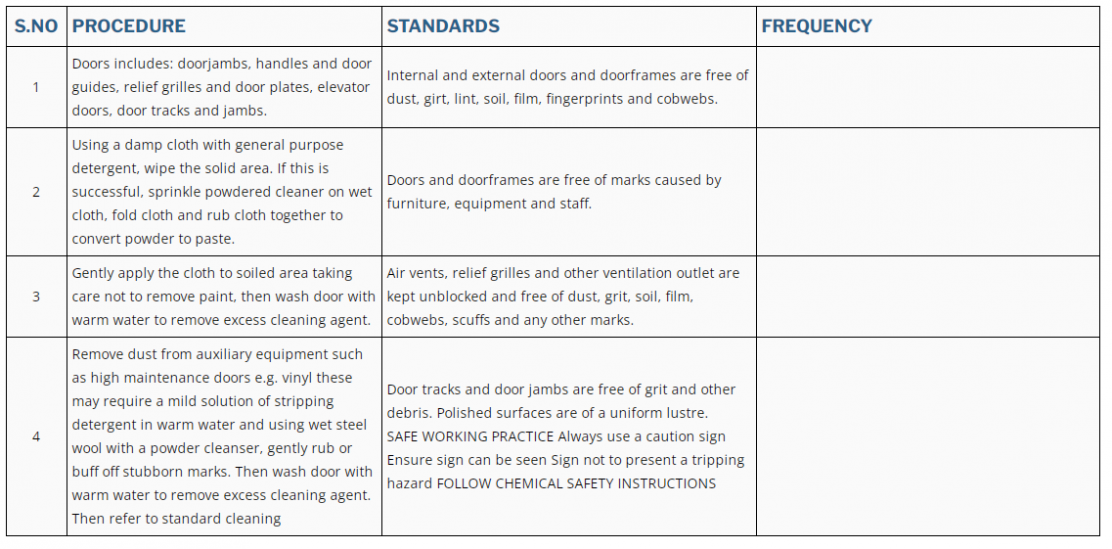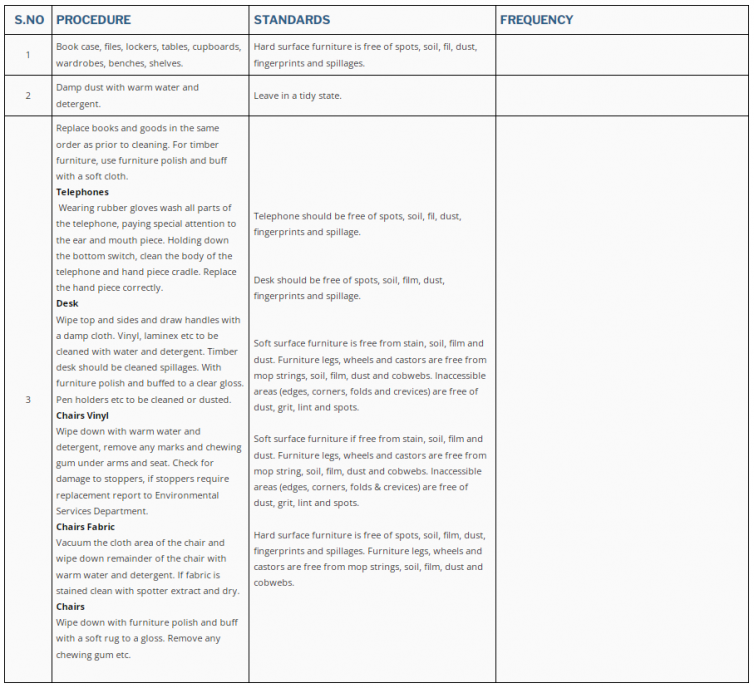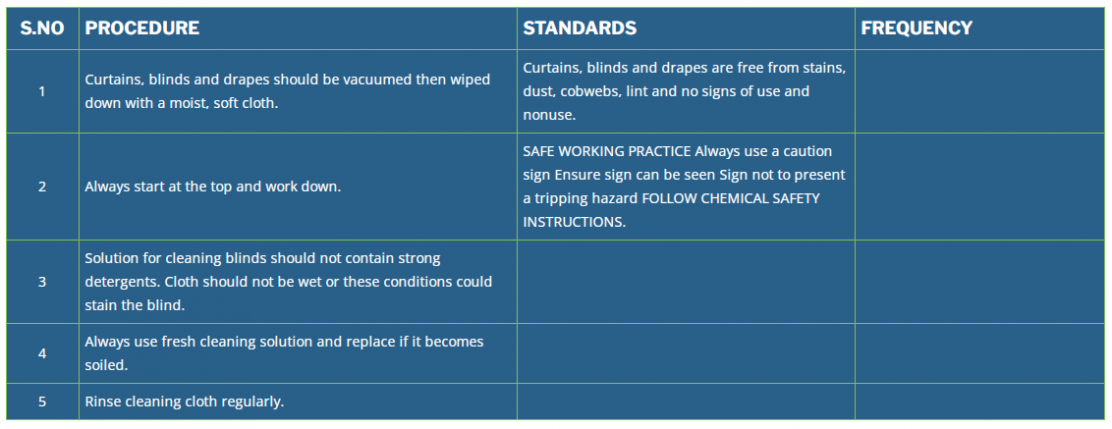With a strategic vision to deliver bespoke services at an affordable cost to the customers, add valve to the customers and crave niche in the highly competitive market. To provide affordable bespoke Hospitality & Housekeeping services with consistency and ensure a clean, safe and healthy environment
Section 4
GENERAL CLEANING
4.1 General Cleaning-Doors
S.NO | Procedure | Standards | Frequency |
1 | Doors includes: doorjambs, handles and door guides, relief grilles and door plates, elevator doors, door tracks and jambs. | Internal and external doors and doorframes are free of dust, girt, lint, soil, film, fingerprints and cobwebs. | |
2 | Using a damp cloth with general purpose detergent, wipe the solid area. If this is successful, sprinkle powdered cleaner on wet cloth, fold cloth and rub cloth together to convert powder to paste. | Doors and doorframes are free of marks caused by furniture, equipment and staff. | |
3 | Gently apply the cloth to soiled area taking care not to remove paint, then wash door with warm water to remove excess cleaning agent. | Air vents, relief grilles and other ventilation outlet are kept unblocked and free of dust, grit, soil, film, cobwebs, scuffs and any other marks. | |
4 | Remove dust from auxiliary equipment such as high maintenance doors e.g. vinyl these may require a mild solution of stripping detergent in warm water and using wet steel wool with a powder cleanser, gently rub or buff off stubborn marks. Then wash door with warm water to remove excess cleaning agent. Then refer to standard cleaning | Door tracks and door jambs are free of grit and other debris. Polished surfaces are of a uniform lustre. SAFE WORKING PRACTICE Always use a caution sign Ensure sign can be seen Sign not to present a tripping hazard FOLLOW CHEMICAL SAFETY INSTRUCTIONS |
4.2 Damp Dusting-Benches, TVs, Locker, Sills, Ledges, etc
S.NO | Procedure | Standards | Frequency |
1 | To be used for window sills, benches, ledges and cupboards/wardrobes/lockers TVs and rails. | Window sills, ledges and tracks are clear and free of dust, grit, marks and spots. | |
2 | Using a clean cloth and recommended detergent and warm water, damp dust all high surfaces that hold dust. Paying special attention to corners etc. Being careful not to wet the surface too much. Change cleaning solution as it becomes visibly soiled. | Cupboards/wardrobes/lockers are clean inside and out and free of dust and litter or stains. SAFE WORKING PRACTICE Always use a caution sign Ensure sign can be seen Sign not to present a tripping hazard FOLLOW CHEMICAL SAFETY INSTRUCTIONS |
4.3 Cleaning-Furniture
S.NO | Procedure | Standards | Frequency |
1 | Book case, files, lockers, tables, cupboards, wardrobes, benches, shelves. | Hard surface furniture is free of spots, soil, fil, dust, fingerprints and spillages. | |
2 | Damp dust with warm water and detergent. | Leave in a tidy state. | |
3 | Replace books and goods in the same order as prior to cleaning. For timber furniture, use furniture polish and buff with a soft cloth. Telephones Wearing rubber gloves wash all parts of the telephone, paying special attention to the ear and mouth piece. Holding down the bottom switch, clean the body of the telephone and hand piece cradle. Replace the hand piece correctly. Desk Wipe top and sides and draw handles with a damp cloth. Vinyl, laminex etc to be cleaned with water and detergent. Timber desk should be cleaned spillages. With furniture polish and buffed to a clear gloss. Pen holders etc to be cleaned or dusted. Chairs Vinyl Wipe down with warm water and detergent, remove any marks and chewing gum under arms and seat. Check for damage to stoppers, if stoppers require replacement report to Environmental Services Department. Chairs Fabric Vacuum the cloth area of the chair and wipe down remainder of the chair with warm water and detergent. If fabric is stained clean with spotter extract and dry. Chairs Wipe down with furniture polish and buff with a soft rug to a gloss. Remove any chewing gum etc.
| Telephone should be free of spots, soil, fil, dust, fingerprints and spillage.
Desk should be free of spots, soil, film, dust, fingerprints and spillage.
Soft surface furniture is free from stain, soil, film and dust. Furniture legs, wheels and castors are free from mop strings, soil, film, dust and cobwebs. Inaccessible areas (edges, corners, folds and crevices) are free of dust, grit, lint and spots.
Soft surface furniture if free from stain, soil, film and dust. Furniture legs, wheels and castors are free from mop string, soil, film, dust and cobwebs. Inaccessible areas (edges, corners, folds & crevices) are free of dust, grit, lint and spots.
Hard surface furniture is free of spots, soil, film, dust, fingerprints and spillages. Furniture legs, wheels and castors are free from mop strings, soil, film, dust and cobwebs. |
4.4 Cleaning-Furniture & Fittings
S.NO | Procedure | Standards | Frequency |
1 | Using warm water and recommended detergent dump dust all furniture and fittings, including chairs, sofas, tools beds, tables, cupboards, wardrobes, lockers, trolleys, benches shelves and storage racks, waste/rubbish receptacles, push plates, fire extinguishers, fire alarms, bed screens, curtains, blinds, drapes, televisions, over bed lights and window sills. | Hard surface furniture is free of spots, soil, fil, dust, fingerprints, and spillages. Soft furniture is free from stains, soil, film and dust. Furniture legs, wheels and castors are free from mop strings, soil, film, dust and cobwebs. | |
2 | Inaccessible areas, edges, corners, folds and crevices are free of dust, grit, lint and spots. | ||
3 | All high surfaces are free from dust and cobwebs. Curtains, blinds and drapes are free from stain, dust, cobwebs, lint and signs of use or non-use. | ||
4 | Equipment is free of tapes/plastic etc which may unpleasant or distasteful. Shelves, bench tops, cup boards and ward robes/lockers are clean inside and Sign not to present a tripping hazard FOLLOW CHEMICAL SAFETY INSTRUCTION. |
4.5 Cleaning-Screen and Screen Rails
S.NO | Procedure | Standards | Frequency |
1 | Screen rails should be damp dusted using warm water and detergent. This includes rail supports. Screen are to be replaced on a set rotation basis or as soon as they are visibly soiled. | Rails be free of dust, cobwebs. | |
2 | Screens should be free from stains, dust, cobwebs, lint and signs of use or non-use. |
4.6 Cleaning-Curtains, Blinds & Drapes
S.NO | Procedure | Standards | Frequency |
1 | Curtains, blinds and drapes should be vacuumed then wiped down with a moist, soft cloth. | Curtains, blinds and drapes are free from stains, dust, cobwebs, lint and no signs of use and nonuse. | |
2 | Always start at the top and work down. | SAFE WORKING PRACTICE Always use a caution sign Ensure sign can be seen Sign not to present a tripping hazard FOLLOW CHEMICAL SAFETY INSTRUCTIONS. | |
3 | Solution for cleaning blinds should not contain strong detergents. Cloth should not be wet or these conditions could stain the blind. | ||
4 | Always use fresh cleaning solution and replace if it becomes soiled. | ||
5 | Rinse cleaning cloth regularly. |
4.7 Cleaning-Vents
S.NO | Procedure | Standards | Frequency |
1 | Vents are vacuumed to remove any dust and wipe out with a damp cloth and detergent. | All ventilation outlets are kept unblocked and free of dust, grit, soil, fil, cobwebs, scuffs and other marks. | |
2 | Some vents require removal to wash the back and entrance of the ducting. | All ventilation outlets are kept clear and uncluttered following cleaning. | |
3 | Metal vent are washed under running water and dried with a lint free cloth to remove stubborn soil age. |
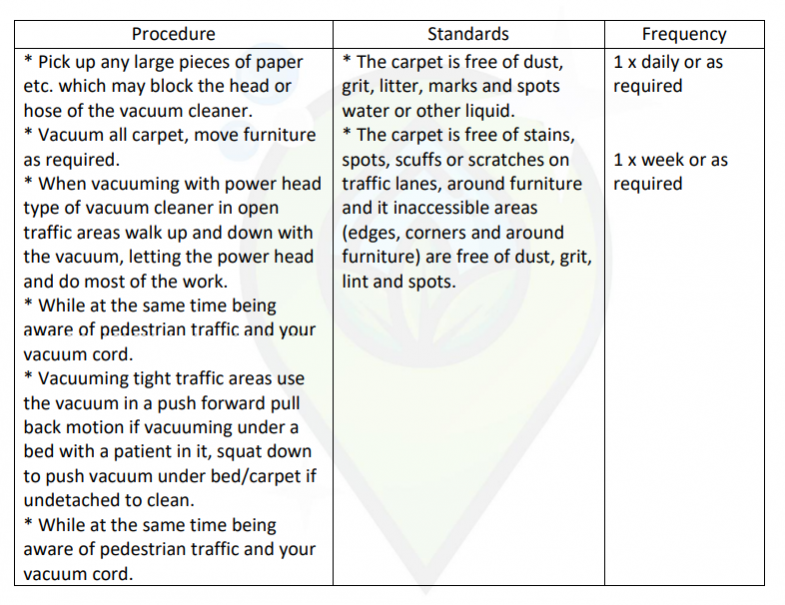
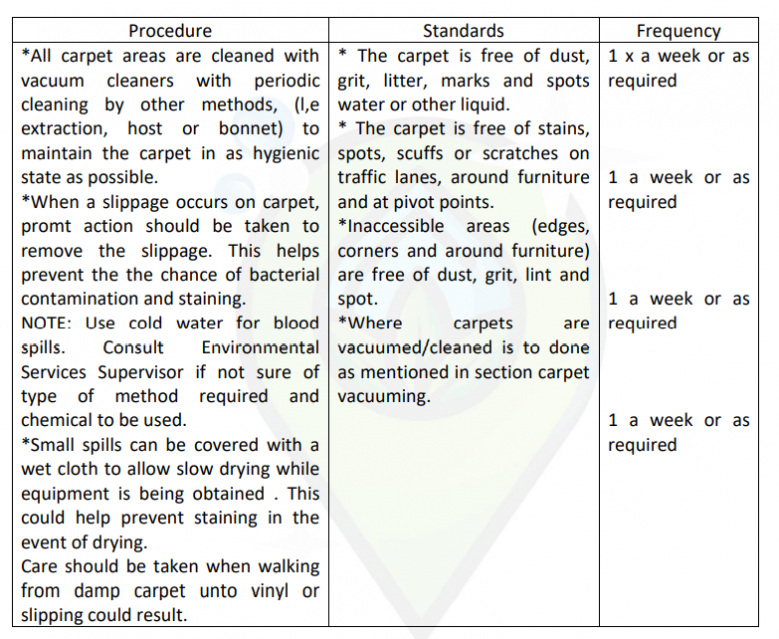


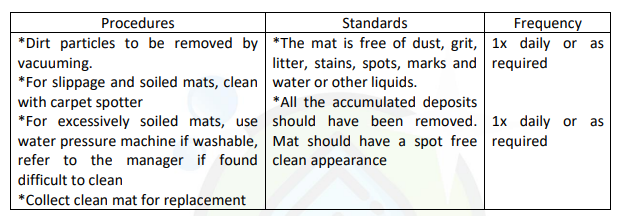



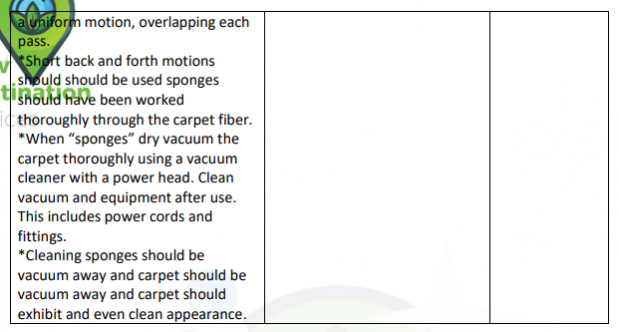
4.8 Damp Dusting-Ceiling and Walls
S.NO | Procedure | Standards | Frequency |
1 | Damp dusting with a sweeping tool should be done with very little moisture (just enough to collect the dust). | Internal and external walls and ceiling are free of dust, grit, lint, soil, film and cobwebs. | |
2 | Damp dusting with the sweeping tool should be done in straight line that overlap one another. | Walls and ceilings are free of marks caused by furniture, equipment or staff. | |
3 | Change dust cover on sweeping tool when soiled. |
4.9 Cleaning-Walls and Ceilings
S.NO | Procedure | Standards | Frequency |
1 | Using a damp cloth or sponge squeeze mop, wash with general purpose detergent and wiped the soiled areas. If this is unsuccessful, sprinkled powder cleaner on wet cloth, fold cloth and rib cloth together to convert powder to a paste. Gently apply cloth to soiled area, taking care not to remove paint, then wash wall with warm water to remove excess cleaning agent. | Internal and external walls and ceilings are free of dust, grit, lint, soil, film and cobwebs. | |
2 | Some vents require removal to wash the back and entrance of the ducting. | Walls and ceilings are free of marks caused by furniture equipment or staff. | |
3 | Metal vent are washed under running water and dried with a lint free cloth to remove stubborn soil age. | Light switches are free of fingerprints, scuff and any other marks. | |
4 | Light covers and diffusers are free of dust, grit, lint and cobwebs. | ||
5 | Polished surfaces are uniform lustre |
